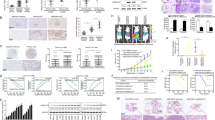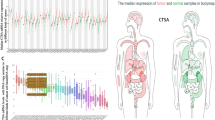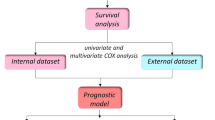Abstract
To identify genes associated with tumor metastasis in hepatocellular carcinoma (HCC), gene expression profiles between a pair of primary HCC (H2-P) and their matched metastatic HCC (H2-M) were compared. Overexpression of clusterin (CLU) was found in H2-M cells. To determine the roles CLU played in HCC metastasis, CLU was transfected into H2-P cells. Overexpression of CLU in H2-P cells increased cell migration by twofold in vitro and formation of metastatic tumor nodules in liver by eightfold in vivo. To evaluate the correlation of CLU expression with HCC metastasis, the expression levels of CLU in HCCs were investigated using a tissue microarray (TMA) containing 104 pairs of primary HCCs and their matched metastases. The frequency of CLU overexpression increased significantly in metastatic HCCs (59.1%) compared with that in primary tumors (32.6%, P<0.001). To gain additional insight into the function of CLU, the expression profile of H2P-CLU was compared with vector-transfected H2-P cells by cDNA microarray. A total of 35 upregulated and 14 downregulated genes were detected in H2P-CLU. One of the upregulated genes known as YKL-40, which is implicated in matrix-remodeling and metastasis, was further studied using TMA. A significant correlation (P<0.001) between the expression levels of YKL-40 and CLU was observed, implying that the CLU-YKL-40 pathway may play an important role in HCC metastasis.
This is a preview of subscription content, access via your institution
Access options
Subscribe to this journal
Receive 50 print issues and online access
$259.00 per year
only $5.18 per issue
Buy this article
- Purchase on Springer Link
- Instant access to full article PDF
Prices may be subject to local taxes which are calculated during checkout






Similar content being viewed by others
References
Blaschuk O, Burdzy K, Fritz IB . (1983). J Biol Chem 258: 7714–7720.
Block TM, Mehta AS, Fimmel CJ, Jordan R . (2003). Oncogene 22: 5093–5107.
Chambers AF, Groom AC, MacDonald IC . (2002). Nat Rev Cancer 2: 563–572.
Chen X, Halberg RB, Ehrhardt WM, Torrealba J, Dove WF . (2003). Proc Natl Acad Sci USA 100: 9530–9535.
Cintin C, Johansen JS, Christensen IJ, Price PA, Sorensen S, Nielsen HJ . (1999). Br J Cancer 79: 1494–1499.
Dehn H, Hogdall EV, Johansen JS, Jorgensen M, Price PA, Engelholm SA et al. (2003). Acta Obstet Gynecol Scand 82: 287–293.
Friedl P, Wolf K . (2003). Nat Rev Cancer 3: 362–374.
Hu L, Lau SH, Tzang CH, Wen JM, Wang W, Xie D et al. (2004b). Oncogene 23: 298–302.
Hu L, Wen JM, Sham JS, Wang W, Xie D, Tjia WM et al. (2004a). Cancer Genet Cytogenet 148: 80–84.
Johansen JS, Cintin C, Jorgensen M, Kamby C, Price PA . (1995). Eur J Cancer 31A: 1437–1442.
Johansen JS, Drivsholm L, Price PA, Christensen IJ . (2004). Lung Cancer 46: 333–340.
Lau SH, Guan XY . (2005). Acta Pharmacol Sin 26: 659–665.
Leskov KS, Klokov DY, Li J, Kinsella TJ, Boothman DA . (2003). J Biol Chem 278: 11590–11600.
Malinda KM, Ponce L, Kleinman HK, Shackelton LM, Millis AJ . (1999). Exp Cell Res 250: 168–173.
Millis AJ, Luciani M, McCue HM, Rosenberg ME, Moulson CL . (2001). J Cell Physiol 186: 210–219.
Mitsunobu M, Toyosaka A, Oriyama T, Okamoto E, Nakao N . (1996). Clin Exp Metastasis 14: 520–529.
Miyake H, Gleave ME, Arakawa S, Kamidono S, Hara I . (2002). J Urol 167: 2203–2208.
Miyata M, Biro S, Kaieda H, Eto H, Orihara K, Kihara T et al. (2001). Circulation 104: 1407–1412.
Nagao T, Inoue S, Yoshimi F, Sodeyama M, Omori Y, Mizuta T et al. (1990). Ann Surg 211: 28–33.
Nishikawa KC, Millis AJ . (2003). Exp Cell Res 287: 79–87.
Pucci S, Bonanno E, Pichiorri F, Angeloni C, Spagnoli LG . (2004). Oncogene 23: 2298–2304.
Redondo M, Villar E, Torres-Munoz J, Tellez T, Morell M, Petito CK . (2000). Am J Pathol 157: 393–399.
Steinberg J, Oyasu R, Lang S, Sintich S, Rademaker A, Lee C et al. (1997). Clin Cancer Res 3: 1707–1711.
Tang ZY, Ye SL, Liu YK, Qin LX, Sun HC, Ye QH et al. (2004). J Cancer Res Clin Oncol 130: 187–196.
Tanwar MK, Gilbert MR, Holland EC . (2002). Cancer Res 62: 4364–4368.
Trougakos IP, Gonos ES . (2002). Int J Biochem Cell Biol 34: 1430–1448.
Wang S, Gao J, Lei Q, Rozengurt N, Pritchard C, Jiao J et al. (2003). Cancer Cell 4: 209–221.
Wang Y, Wu MC, Sham JS, Zhang W, Wu WQ, Guan XY . (2002). Cancer 95: 2346–2352.
Xie D, Lau SH, Sham JS, Wu QL, Fang Y, Liang LZ et al. (2005). Cancer 103: 277–283.
Acknowledgements
This study is supported in part by a Research Grant Council Grant HKU 7393/04M (Hong Kong), donations from Mr Heung Chit Kau, the Areas of Excellence Scheme (AoE/P-10/01) of the University Grants Committee (Hong Kong), and the China National ‘863’ Hi-tech Program (2003AA2Z2052).
Author information
Authors and Affiliations
Corresponding author
Rights and permissions
About this article
Cite this article
Lau, S., Sham, J., Xie, D. et al. Clusterin plays an important role in hepatocellular carcinoma metastasis. Oncogene 25, 1242–1250 (2006). https://doi.org/10.1038/sj.onc.1209141
Received:
Revised:
Accepted:
Published:
Issue Date:
DOI: https://doi.org/10.1038/sj.onc.1209141
Keywords
This article is cited by
-
The role and function of CLU in cancer biology and therapy
Clinical and Experimental Medicine (2022)
-
Diagnostic value of clusterin immunostaining in hepatocellular carcinoma
Diagnostic Pathology (2020)
-
Decreased circulating clusterin reflects severe liver complications after hepatoportoenterostomy of biliary atresia
Scientific Reports (2020)
-
Chitinase-3 like-protein-1 function and its role in diseases
Signal Transduction and Targeted Therapy (2020)
-
Indole-3- carbinol enhances sorafenib cytotoxicity in hepatocellular carcinoma cells: A mechanistic study
Scientific Reports (2016)



